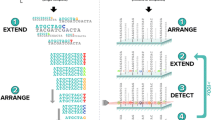Abstract
DNA sequencing has had large impact on basic research and medical diagnosis. In recent years, next generation sequencing technologies have increased the sequencing speed and turnaround by magnitudes and slashed the costs. Here, we summarize different approaches and give examples for their application in clinical settings.
Similar content being viewed by others
Literatur
Majewski J, Schwartzentruber J, Lalonde E et al. (2011) What can exome sequencing do for you? J Med Genet 48:580–589
Veritas Genetics (2016) Veritas genetics launches $999 whole genome and sets new standard for genetic testing. Press Release, www.veritasgenetics.com/documents/VGlaunches-999-whole-genome.pdf
Sanger F, Nicklen S, Coulson AR (1977) DNA sequencing with chain-terminating inhibitors. Proc Natl Acad Sci USA 74:5463–5467
Goodwin S, McPherson JD, McCombie WR (2016) Coming of age: ten years of next-generation sequencing technologies. Nat Rev Genet 17:333–351
Koboldt DC, Steinberg KM, Larson DE et al. (2013) The next-generation sequencing revolution and its impact on genomics. Cell 155:27–38
OMIM Entry Statistics–Number of Entries in OMIM (updated 11.1.2017), https://www.omim.org/statistics/entry
Meyts I, Bosch B, Bolze A et al. (2016) Exome and genome sequencing for inborn errors of immunity. J Allergy Clin Immunol 138:957–969
Schubert D, Bode C, Kenefeck R et al. (2014) Autosomal dominant immune dysregulation syndrome in humans with CTLA4 mutations. Nat Med 20:1410–1416
Wetterstrand KA (2016) DNA Sequencing Costs: Data from the NHGRI Genome Sequencing Program (GSP). National Human Genome Research Institute, www.genome.gov/sequencingcostsdata
Author information
Authors and Affiliations
Corresponding author
Additional information
Dietrich August Jahrgang 1990. 2009–2016 Medizinstudium am dem Universitäten Freiburg und Wien, Österreich. Seit 2014 Promotion am Centrum für Chronische Immundefizienz (CCI).
Bodo Grimbacher Jahrgang 1967. Humanmedizinstudium an den Universitäten Aachen, Freiburg und Hamburg. 1995 Promotion, 1997–2000 DFG-Forschungsaufenthalt an den National Institutes of Health, Bethesda, MA, USA. 2001–2006 Emmy-Nöther Fellow der DFG, 2006 Facharzt für Innere Medizin, Habilitation und Ruf an das University College London, UK. 2006–2011 Marie-Curie Fellow der EU. 2011 Ruf an die Universität Freiburg. Seither Wissenschaftlicher Direktor des Centrums für Chronische Immundefizienz (CCI).
Rights and permissions
About this article
Cite this article
August, D., Grimbacher, B. Entwicklung der genetischen Diagnostik. Biospektrum 23, 37–40 (2017). https://doi.org/10.1007/s12268-017-0764-x
Published:
Issue Date:
DOI: https://doi.org/10.1007/s12268-017-0764-x




